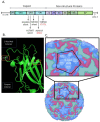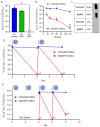Broad-Spectrum, Potent, and Durable Ceria Nanoparticles Inactivate RNA Virus Infectivity by Targeting Virion Surfaces and Disrupting Virus-Receptor Interactions
- PMID: 37446852
- PMCID: PMC10343717
- DOI: 10.3390/molecules28135190
Broad-Spectrum, Potent, and Durable Ceria Nanoparticles Inactivate RNA Virus Infectivity by Targeting Virion Surfaces and Disrupting Virus-Receptor Interactions
Abstract
There is intense interest in developing long-lasting, potent, and broad-spectrum antiviral disinfectants. Ceria nanoparticles (CNPs) can undergo surface redox reactions (Ce3+ ↔ Ce4+) to generate ROS without requiring an external driving force. Here, we tested the mechanism behind our prior finding of potent inactivation of enveloped and non-enveloped RNA viruses by silver-modified CNPs, AgCNP1 and AgCNP2. Treatment of human respiratory viruses, coronavirus OC43 and parainfluenza virus type 5 (PIV5) with AgCNP1 and 2, respectively, prevented virus interactions with host cell receptors and resulted in virion aggregation. Rhinovirus 14 (RV14) mutants were selected to be resistant to inactivation by AgCNP2. Sequence analysis of the resistant virus genomes predicted two amino acid changes in surface-located residues D91V and F177L within capsid protein VP1. Consistent with the regenerative properties of CNPs, surface-applied AgCNP1 and 2 inactivated a wide range of structurally diverse viruses, including enveloped (OC43, SARS-CoV-2, and PIV5) and non-enveloped RNA viruses (RV14 and feline calicivirus; FCV). Remarkably, a single application of AgCNP1 and 2 potently inactivated up to four sequential rounds of virus challenge. Our results show broad-spectrum and long-lasting anti-viral activity of AgCNP nanoparticles, due to targeting of viral surface proteins to disrupt interactions with cellular receptors.
Keywords: anti-viral; coronavirus; disinfectant; nanoparticles; norovirus; parainfluenza; rhinovirus; virucidal.
Conflict of interest statement
C.D. commercialization of AgCNPs through Kismet Technologies.
Figures








Similar articles
-
Metal-Mediated Nanoscale Cerium Oxide Inactivates Human Coronavirus and Rhinovirus by Surface Disruption.ACS Nano. 2021 Sep 28;15(9):14544-14556. doi: 10.1021/acsnano.1c04142. Epub 2021 Aug 26. ACS Nano. 2021. PMID: 34436866
-
Potent Inactivation of Human Respiratory Viruses Including SARS-CoV-2 by a Photoactivated Self-Cleaning Regenerative Antiviral Coating.ACS Appl Mater Interfaces. 2022 Sep 14;14(36):40659-40673. doi: 10.1021/acsami.2c11653. Epub 2022 Aug 25. ACS Appl Mater Interfaces. 2022. PMID: 36004755
-
Inactivation of Non-Enveloped Viruses and Bacteria by an Electrically Charged Disinfectant Containing Meso-Structure Nanoparticles via Modification of the Genome.Int J Nanomedicine. 2020 Feb 28;15:1387-1395. doi: 10.2147/IJN.S229880. eCollection 2020. Int J Nanomedicine. 2020. PMID: 32184593 Free PMC article.
-
Properties of Coronavirus and SARS-CoV-2.Malays J Pathol. 2020 Apr;42(1):3-11. Malays J Pathol. 2020. PMID: 32342926 Review.
-
Antiviral nanoparticles for sanitizing surfaces: A roadmap to self-sterilizing against COVID-19.Nano Today. 2021 Oct;40:101267. doi: 10.1016/j.nantod.2021.101267. Epub 2021 Aug 13. Nano Today. 2021. PMID: 34404999 Free PMC article. Review.
Cited by
-
Inorganic Nanoparticles as Radiosensitizers for Cancer Treatment.Nanomaterials (Basel). 2023 Oct 30;13(21):2873. doi: 10.3390/nano13212873. Nanomaterials (Basel). 2023. PMID: 37947718 Free PMC article. Review.
-
Aptamer-decorated nanocarriers for viral adsorption: A special look at COVID-19.Mol Ther Nucleic Acids. 2024 Aug 15;35(3):102310. doi: 10.1016/j.omtn.2024.102310. eCollection 2024 Sep 10. Mol Ther Nucleic Acids. 2024. PMID: 39281706 Free PMC article. Review.
-
Exploration of inorganic nanoparticles for revolutionary drug delivery applications: a critical review.Discov Nano. 2023 Dec 19;18(1):157. doi: 10.1186/s11671-023-03943-0. Discov Nano. 2023. PMID: 38112849 Free PMC article. Review.
References
-
- Knipe D.M., Howley P. Fields Virology. Volumes 1 and 2 LWW; Philadelphia, PA, USA: 2013.
-
- Ikonen N., Savolainen-Kopra C., Enstone J.E., Kulmala I., Pasanen P., Salmela A., Salo S., Nguyen-Van-Tam J.S., Ruutu P., PANDHUB consortium Deposition of respiratory virus pathogens on frequently touched surfaces at airports. BMC Infect. Dis. 2018;18:437. doi: 10.1186/s12879-018-3150-5. - DOI - PMC - PubMed
MeSH terms
Substances
Grants and funding
LinkOut - more resources
Full Text Sources
Medical
Miscellaneous

